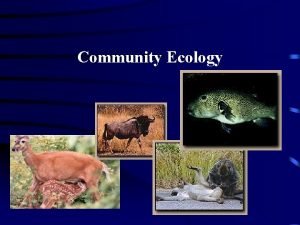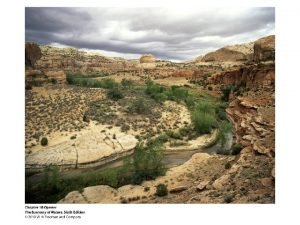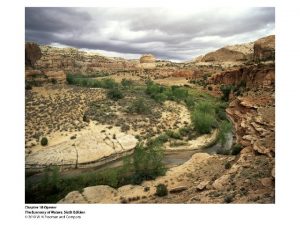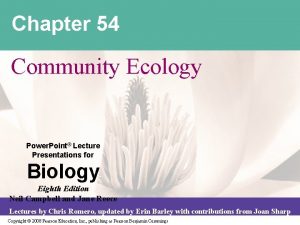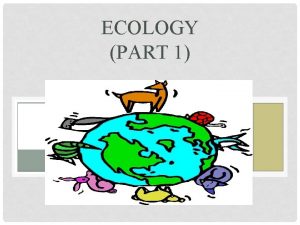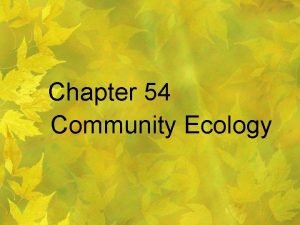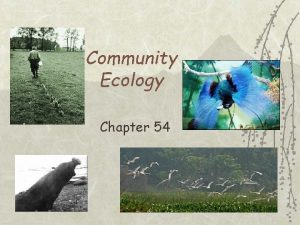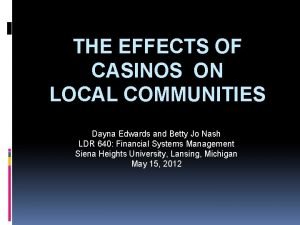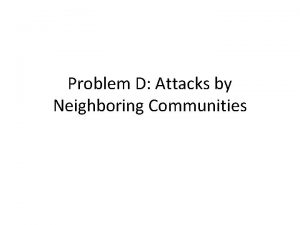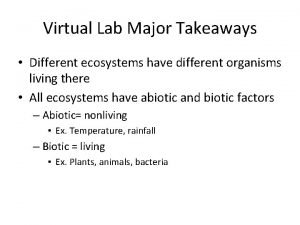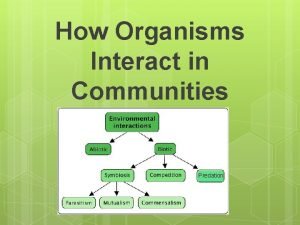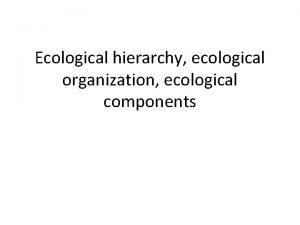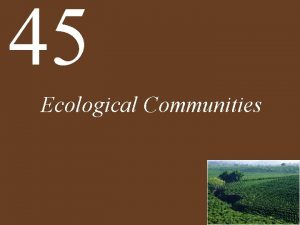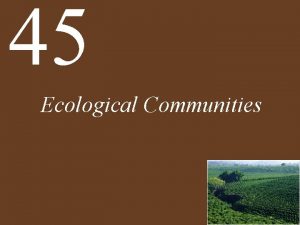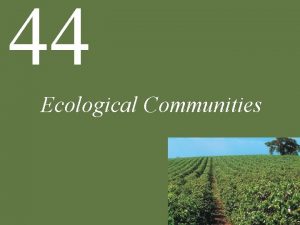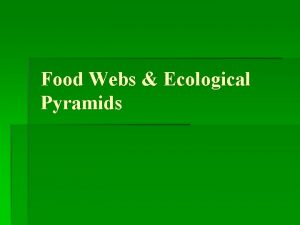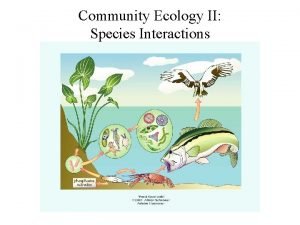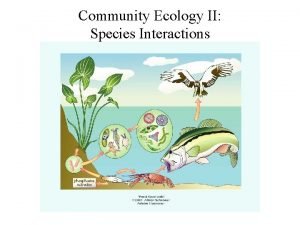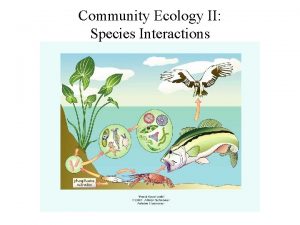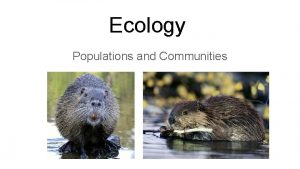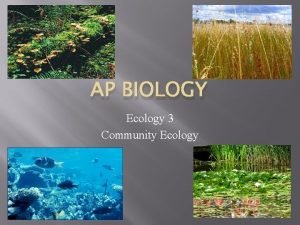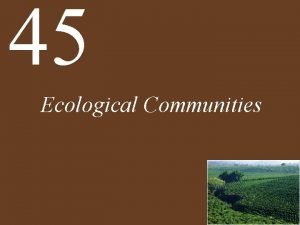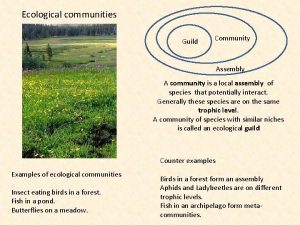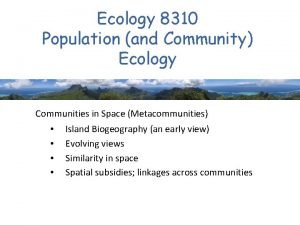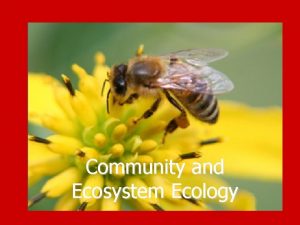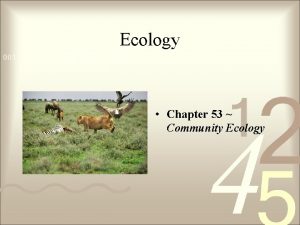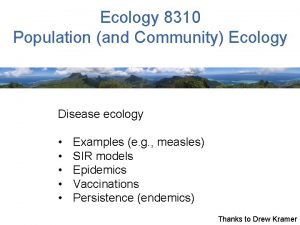COMMUNITY ECOLOGY COMMUNITY ECOLOGY What are ecological communities


























- Slides: 26

COMMUNITY ECOLOGY

COMMUNITY ECOLOGY: • What are ecological communities? • Definition: • COMMUNITY: • A community is a collection of populations of all the organisms which occur together in a given place and time. • COMMUNITY ECOLOGY: • Community ecology is the study of the interactions between these organisms, and the interactions between the organisms and their environment. • Communities can have emergent properties which


COMMUNITY ECOLOGY • The term ‘community’ is also commonly used to refer to a subset of populations within the whole community, for example we talk about plant communities, insect communities, arthropod communities, small mammal communities, etc.

SPECIES INTERACTION • Species interactions Within communities there a variety of ways in which organisms can interact with each other. There also a variety of ways in which these interactions have been classified by ecologists.


COMPETITION: Definition : Competition occurs when the interaction between organisms results in a reduction of growth, survival or reproduction for both partners of the interaction. 1 EXPLOITATION COMPETITION: • involves the use of a limiting resource • Limiting resources for plants include light, water and nutrients, for animals they include food, shelter and nesting sites. 2 INTERFERENCE COMPITITION: • occurs when individuals directly interact • such as two animals fighting for a territory, or allelopathy - the production of chemicals by one organism which are toxic to another.

TYPES OF COMPETITION: Competition can be of two types; • INTRASPECIFIC COMPETITION: • Intraspecific competition occurs between individuals of the same species/population EXAMPLES: • self-thinning in crops or forest plantations, competition for females among kangaroo males. • INTERSPECIFC COMPETITION: • Interspecific competition involves individuals from different species/populations • EXAMPLES: • weeds and the crop in an agricultural field, marsupials and birds competing for nesting sites in dead trees.


PREDATION Defiinition • Predation is the consumption of one living organism (prey, plant or host) by another (predator, grazers or parasite). The key idea is that one member (the predator) benefits to the detriment of the other (the prey). • CLASSES OF PREDATION INTERACTION: • Herbivory is the consumption of plant material by plant eating animals (herbivores Parasitism: • Parasites are generally much smaller than their host and grow and/or reproduce inside • (endoparasites) • (ectoparasites) of the living host.

MUTUALISM • Mutualism occurs when both populations/individuals benefit from the presence of each other. • Example • mutualistic interaction with mycorrhizal fungi which live on or in the root surface. • pairwise interaction • multi-species interactions

DO COMMUNITIES EXIST? • The question of whether communities have properties of their own which are more than the sum of their parts has been debated for a long time. originally attributed to Gleason (1926). Under this view, communities are not tightly structured, but are merely coincidences resulting from chance dispersal • Communities with internal purpose exist to take care of themselves. • Communities with external purpose exist to pursue an external goal.

WHAT IS ‘COMMUNITY STRUCTURE’? Community structure in general: • wide range of phenomenon resulting from the formation of ecological communities. • In ecology , limitations set by species interactions on which species can coexist with which others. • ‘Community structure’ is also used to describe the physical arrangement of species in a community, such as the vertical arrangement of species in a forest (trees, shrubs and ground growing herbaceous (non-woody) plants.

WAYS OF GROUPING SPECIES: • Guilds: • A guild is a group of species which utilise resources in a similar way (Root 1967). • EXAMPLES: For example, a group of fruit eating birds in a rainforest, a guild of forest-floor dwelling herbs. • Note that because species within a guild utilise the same resources, • Functional types: • Functional types are groupings of organisms which respond similarly to a particular disturbance. • The groupings can include species, or subspecies, or phenotypes which differentially respond to the disturbance, or even different stages in the life history of the same species. • Trophic levels: • food webs are included in it. • A food web is a graph of the various trophic levels in a community (carnivores,

MECHANISMS STRUCTURING ECOLOGICAL COMMUNITIES The ecological niche: • multidimensional description • resource needs • habitat requirements • environmental tolerances (Hutchinson 1957). The fundamental niche is the potential set of conditions which a species can occupy. • It can be determined experimentally. • The niche concept can be further split into two distinct aspects. • (I)Geographic niche, Conditions niche or Beta niche: This simply states that some species live in different


THE RELATIONSHIP BETWEEN THE ECOLOGICAL NICHE AND SPECIES COEXISTENCE: • The principle of competitive exclusion, also known as Gauss’s principle, states no two species which share the same niche can permanently coexist. • superior competitor will eventually exclude the weaker competitor. Coexistence between competitors is therefore related to the overlap between similar species.

MECHANISMS OF INTERCROP ADVANTAGE: • 1)Firstly • the various crop species in the mixture can be chosen so that they do not compete strongly with each other. • i. e. their niche overlap is sufficiently low. • 2)Secondly • an increase in crop performance can arise • Modifies the environment in a positive way

METHODS USED TO DESCRIBE ECOLOGICAL COMMUNITIES: • Spatial patterns, mosaics, gradients and ecotones • Community composition changes in space. The way in which this happens is the spatial pattern. Community composition also changes in time. We can describe the spatial pattern with respect to any of the following: • Mosaic patterns occur when there is a patchwork of communities with different compositions. • Gradients: • Gradients are encountered when there is a gradual change in space of some environmental factor.

FIELD SURVEYS AND MULTI-VARIATE METHODS These are statistical tools which allow us to identify species groupings according to their patterns of co-occurrence. An Ordination is a map which groups sampling units together on the basis of their similarity of species composition and abundance.

WHAT IS (BIO)DIVERSITY? • Definition: “Biological Diversity is • the variety of all life forms of different plant • animals • micro-organism • the genes they contain and the ecosystems they form”. • Note the breadth of this definition; it covers not only diversity in terms of the number of species, but also the genetic information contained within individual organisms, as well as the diversity of habitats, natural communities and ecological processes in the biosphere.

GENETIC DIVERSITY • Definition: • Strictly speaking, genetic diversity refers to the diversity of genotypes within a population or species. Methods to measure genetic diversity • Morphological studies: • If a trait has a simple genetic determinism (i. e. it is determined by one or a few genes) • it is possible to study genetic diversity by simply measuring the frequencies. • phenotypes • The existence of two or more phenotypes in a population is called polymorphism. • Electrophoresis • This is a chemical technique which allows the range of different forms of the same protein within a population to be measured.

WHY IS GENETIC DIVERSITY IMPORTANT? • for evolutionary change • it is effectively the species 'life insurance' against environmental change, accidental reductions in population size and attack from enemies such as disease and herbivores.

PATTERNS OF SPECIES DIVERSITY: • Patterns of species diversity: There are geographic factors such as • altitude • latitude and depth for aquatic environments • Climate variability • Finally, biotic factors also influence diversity. These include the amount of predation or competition, or the complexity of the vertical structure of the community • Diversity and Stability: • Ecologists have long been interested in community stability • Unfortunately, the evidence from natural communities is both sparse and inconclusive. the results from two recent studies, both of which imply that the species-rich plant communities studied were more resistant to disturbance than comparable species-poor communities, suggesting that preservation of biodiversity is essential for the maintenance of these communities. To conclude, the relationship between complexity and stability cannot be conveniently generalised, as was originally hoped. It depends on the type of disturbance applied, and the particular characteristics of the community to which it is applied.


THANK S
 Insidan region jh
Insidan region jh What are the steps of secondary succession
What are the steps of secondary succession Cheetahs can run extremely fast because
Cheetahs can run extremely fast because Chapter 5 evolution and community ecology
Chapter 5 evolution and community ecology Community ecology
Community ecology Definition of community ecology
Definition of community ecology Community definition ecology
Community definition ecology Chapter 3, section 1: community ecology answer key
Chapter 3, section 1: community ecology answer key More diverse
More diverse Population vs community ecology
Population vs community ecology Symbiosis examples
Symbiosis examples Community ecology
Community ecology Chapter 54: community ecology answer key
Chapter 54: community ecology answer key Chapter 5 evolution and community ecology
Chapter 5 evolution and community ecology Population vs community ecology
Population vs community ecology Chapter 54 community ecology
Chapter 54 community ecology Evolution and community ecology guided notes
Evolution and community ecology guided notes Negative effects of casinos on communities
Negative effects of casinos on communities Attacks by neighboring communities
Attacks by neighboring communities Communities and biomes virtual lab answers
Communities and biomes virtual lab answers Osu living learning communities
Osu living learning communities Parasitism
Parasitism Ventfish
Ventfish Communities in society
Communities in society Coalition evaluation for communities
Coalition evaluation for communities Communities are not built of friends
Communities are not built of friends People living together in a community
People living together in a community




